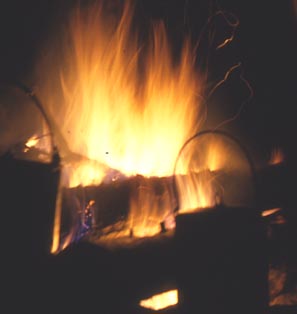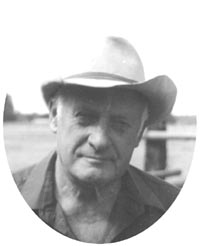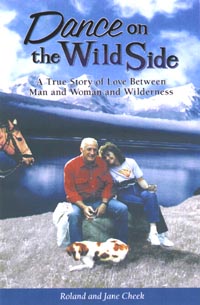a weblog sharing info on outdoor skills and campfire musing by a guy who spends a bunch of time in pursuit of both
CULTURE
WHERE -
TALES ARE TOLD OF
Welcome to Roland Cheek's Weblog
Roland is a gifted writer with a knack for clarifying reality. Looking forward to more of his wisdom
- Carl Hanner e-mail
Lee M. Talbot wrote -- Until recently, most people believed that effective wildlife conservation consisted primarily of protecting animals against wanton killing or capture. And they were right -- at least in part. Since man first appeared on earth, he has driven a number of species to extinction. But all the armies in the world cannot save an animal if it has no place to live, no place to hide, no food to eat. in the years to come, even more so than in the past, the most critical threat to wild animals will not be direct physical assault by man, but rather his destruction of their habitat . . . it is far more difficult to sell the idea of preserving habitat . . . But let's start at the beginning.
To access Roland's weblog and column archives
Click Here
Tip o' the Day
In my mind, kids and colts make a poor combination. Sure, colts are cute and kids are cute. Why shouldn't they grow up together? Johnny or Susy can learn to ride at the same time Ginger learns to be ridden -- right?
Nope. That cute and cuddly colt will grow up much more swiftly than Susy or Johnny. Instead of a cute and cuddly colt, Ginger soon becomes pushy and demanding and spirited and so dangerous that the kids wind up fearing all horses. In my considerable experience, "kid spoiled" horses are to be avoided like the plague -- most especially by kids.
Youngsters should always be started on older horses. Chances are good older experienced horses have rounded a trail bend and came eyeball to eyeball with a grazing bear. Or kicked over a hornet nest. Or stumbled from a hillside trail after dark. Or had kitchenware shake loose inside a packbox they carried. or suffered a saddle that rolled beneath their belly during an impromptu shuffle. An animal with that kind of experience isn't like to injure your child.
It's a rare pony I'd trust with guests until that pony was eight or ten, and had some backcountry trail experience. I would never hesitate to buy a 16- or 18-year-old horse for my grandkids; especially one who acts eager and is plumb gentle.
Most people fail to realize that a 16-year-old horse still has many good years left, provided he's used properly. Such a pony can have upwards of ten to fifteen good years left. Let's say Susy or Johnny is six or eight years old. Do the math! They'll be on their way to college by the time their beloved horse passes over the Great Divide.
Meanwhile they've learned to ride, learned to love animals, and learned responsibilty for a creature they love.
Older horses together with younger kids ae win-win in every respect, perhaps even more so for moms and dads who need not get ulcers every time Susy goes to the corral with sugar cubes in her pocket.
I know lots of kids who started with an older pony, then graduated to something more spirited after they learned how to handle horses. Then is the time for them to start a colt.
A 13- or 14-year-old young man or young woman with prior horse experience will be able to raise and train that colt to perfection. But they'll only succeed if they've, in turn, been raised to perfection by an honorable older horse who loves being pampered by their young friend.
My all-time favorite saddlehorse Buck, whom I wish someday to present in a book that will sell millions of copies to readers of this weblog, wanted nothing to do with retirement at age 25. Instead, the big pony kept trying to crowd into the stock truck as I began loading stock for a wilderness trip. I finally gave up and allowed him to go.
Buck was 29 when Jane and I sold the outfitting business in 1990. You could say Buck and I retired together. He lived three more years.
MOTHER'S SPECIAL TREAT
It's appropriate that the 98th anniversary of establishment of Glacier National Park occurs this month, near Mother's Day. You see, over the years, Glacier has been good to our kids' mother on her special day.
We tend to be a regimented family, doing over and over the things that work for us. For instance, during our plus-50 years of marriage, there's been an orchid corsage for Jane on her day. Then the kids horned in by making it their practice to pick a single pink calypso orchid from the woods behind our home--a tradition I've continued after the rug rats left home for far-off places.
Custom also evolved that we visit Glacier Park on Mother's Day. Back years ago, if the road opened early enough to get there, we picnicked at Bowman lake. Usually snowbanks were still plentiful, though the beach and most of the picnic area was bared. And boy howdy, was the view outside our picnic picture window spectacular!
Most of the time we had the place pretty much to ourselves. We feasted on delicacies such as wieners charcoaled over an open fire, potato salad, deviled eggs, sliced fruit and soda pop. Jane usually napped after lunch while I played a pick-up softball game with the kids to keep them out of her hair.
Then it was home in late afternoon, wending our relaxed way down the graveled and washboard North Fork Road, kids asleep in the back seat of the Jeep wagon, while Jane snuggled close in satisfaction.
Changes were made after our children left their nest. For the last several years Jane has spent her special day looking for grizzly bears (she lets me tag along, too). More often than not, she'll spot one and figure she got her Mother's Day "fix." Sometimes we count those sightings as among the greatest experiences of our lives.
He was a swaggering sunlit boar grazing, near the break of day, in a peat moss bog. The bear was easily two hundred yards away and fifty feet below. We stood amid scattered lodgepole pines, with climbable fir trees only a few feet distant. A gentle breeze wafted to our face; we could not possibly have been more secure. As you might guess, we watched that big silvertip until he wandered away, an hour and a half later.
There've been other grizzlies spotted on other Mother's Days, too. But none so exciting and educational as that peat bog monster.
*
Establishing Glacier National Park was far more difficult than hindsight would lead one to believe. As odd as it may seem today, Kalispell's Chamber of Commerce lobbied against its creation. As Sidney M. Logan, a prominent Kalispell attorney testified, the Park would lock up exploitable natural resources, remove valuable homestead land from the public rolls, and stop more railroads from building into the area.
The Columbia Falls Columbian editorialized, Feb. 3, 1910: "... The proposed park is covered with a fine growth of saw timber and this should be placed under regulations similar to the forest reserves so that the timber could be cut from time to time as it matures. Provisions should be made to allow mineral prospectors to go on the ground in search of minerals."
Glacier National Park has not, of course, been the economic catastrophe local opponents predicted, annually bringing in millions of dollars via visitors from all over the world. In fact, it would be interesting to see the reaction of today's Kalispell Chamber if any kind of current attempt was made to remove Glacier from the National Park System.
Roland Cheek wrote a syndicated outdoors column (Wild Trails and Tall Tales) for 21 years. The column was carried in 17 daily and weekly newspapers in two states. In addition, he scripted and broadcast a daily radio show (Trails to Outdoor Adventure) that aired on 75 stations from the Atlantic seaboard to the Pacific Ocean. He's also written upwards of 200 magazine articles and 12 fiction and nonfiction books. For more on Roland, visit:
www.rolandcheek.com
Recent Weblogs
Tuesday, May 6, 2008
For more info about these and other Roland Cheek books
There's a bunch of specific info about Roland's books, columns, archives and radio programs. By clicking on the button to the left, one can see Roland's synopsis of each book, read reviews, and even access the first chapter of each of his titles. With Roland's books, there's no reason to buy a "pig in a poke."
for detailed info about each of Roland's books
Read Reviews
Read their first chapters
For interested educators, this weblog is especially applicable for use in history, relationships, and government classes, as well as for journalism students.
Roland, of course, visits schools. For more information on his program alternatives, go to:
NEXT WEEK:
NOTHING IS FOREVER
www.campfireculture.com
The Phantom Ghost of Harriet Lou is a 352-page book about "the creature that," Roland claims, "took me to the wildlife dance." Packed with exciting tales from the years he both hunted elk, and guided others to their lifetime dreams
The best of Roland's 2,700 newspaper columns and radio program scripts. Mostly humor, all personal
Dance On the Wild Side, the story of Roland's & Jane's life together, from childhood sweethearts through five decades of wild adventure!
Two exciting books about the creature Roland says "keeps me dancing."
Learning To Talk Bear is Roland's best selling book, now in its 5th printing. The book describes Roland's own learning experience about the great beasts, profiling several different animals throughout portions of their lives.
Chocolate Legs is an entire book about a single charismatic Glacier National Park grizzly bear who became infamous, with ink spread across Associated Press and the New York Times.
Montana's Bob Marshall Wilderness 9 X 12 Coffee Table book, with 97 full color photos on 80 pages, PLUS 10,000 words of "how-to," "where-to" text about the Wlderness one Chief of the U.S. Forest Service called "The Crown Jewell of Our Wilderness System," and another called "The Flagship of America's Wilderness Fleet." The first book ever published about that splended land God insisted on keeping as his own -- just the same as in 1982, when Roland photographed and wrote the book.
source links for additional info
to send this weblog to a friend
to tell Roland what you think of his Campfire Culture weblog
to visit Roland's newspaper columns and weblog archives








